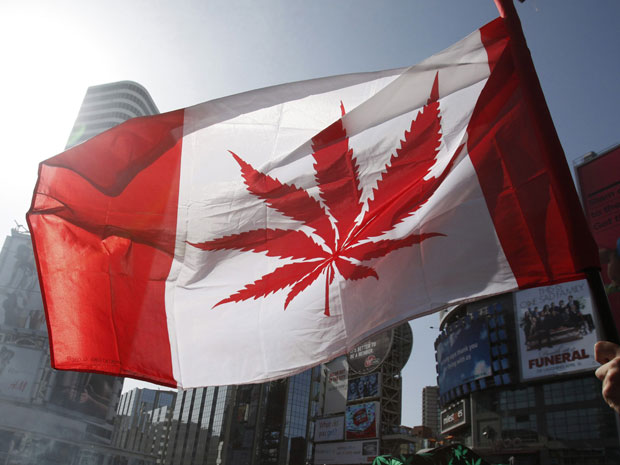You are here
Home 🌿 Recreational Marijuana News 🌿 Here’s what you need to know about Canada’s marijuana legalization 🌿Here’s what you need to know about Canada’s marijuana legalization

Canada is legalizing adult use of marijuana on Oct. 17 and will be the second and largest country to do so.
The federal government established the broad outline of the legalization law but left it up to provinces and territories to fill in some of the details – such as whether to allow home grows, to establish a legal purchase age of 18 or 19, and whether to sell through government-run pot shops or private outlets.
Here’s a look at how the industry will look, as well as some key differences between Canada’s approach and that of the nine U.S. states that have legalized so-called recreational marijuana:
What's allowed
Canada’s Cannabis Act allows people 18 and older to buy marijuana online or in retail stores. Most provinces have raised the minimum age to 19, however, to align with the drinking age. In the U.S., states with recreational legalization have an age limit of 21, which matches the drinking age.
Wallis Muir, right, an employee at the Village Bloomery medical cannabis dispensary in Vancouver, British Columbia, helps customer Dolores Bzdel, left, make a purchase in September. On Oct. 17, Canada will become the second and largest country with a legal national marijuana marketplace, forcing many dispensaries, including the Village Bloomery, to stop selling many products, including vape pens, that they currently carry.
Impaired driving, border crossings
Some U.S. states, including Washington and Colorado, test a driver’s blood for marijuana impairment. In Canada, officers will for now rely on traditional observations in enforcing driving laws, but provinces say they could adopt saliva tests if one is approved by the federal government.
While authorities have placed signs on the Canadian side of the border alerting travelers that it remains illegal to bring marijuana into the U.S., some may not realize they can be barred from crossing for admitting to marijuana use. The same goes for those who tell U.S. authorities they work in the legal Canadian industry.
“We’re going to see a big problem at the Canada-U.S. border,” said Peter MacKay, a former Conservative Party justice, defense and foreign minister. “It’s going to be thousands if not hundreds of thousands of Canadians who are suddenly going to find themselves inadmissible to the United States.”
Government involvement
A key difference between the Canadian and American models is government involvement. The main federal effort in the U.S. is to enforce drug laws that still treat marijuana as a controlled substance.
In Canada, the federal government regulates producers. Canada so far has licensed some 120 growers.
The provinces are tasked with overseeing distribution. Some will buy wholesale marijuana and deliver it to retail stores and, through the federal postal service, to online customers. The government involvement in distribution could help control prices, keeping them at a level that is competitive with the black market without allowing overproduction to threaten the viability of licensed producers, experts say.
In some U.S. states, especially Oregon, an oversupply of legal pot has raised concerns about product being diverted to other states.
The regulation spectrum
The only other country to legalize marijuana is South America’s Uruguay, which has taken an extremely deliberate and strict approach. There, pharmacies sell to adults over 18, who can buy up to 40 grams per month – an amount tracked with fingerprint recognition. Only two types of cannabis are available.
At the other end of the regulation spectrum are U.S. states, where legalization has prompted a sort of green rush, with companies trying to get rich selling products from vape cartridges to pre-rolled joints to pot-infused sodas.
Canada is somewhere in the middle. Some licensed producers are huge companies, but there are also strict regulations on packaging to avoid appealing to youth and a ban on many types of marijuana advertising, including any that could be seen by youth or that uses depictions of celebrities.
420 Intel is Your Source for Marijuana News
420 Intel Canada is your leading news source for the Canadian cannabis industry. Get the latest updates on Canadian cannabis stocks and developments on how Canada continues to be a major player in the worldwide recreational and medical cannabis industry.
420 Intel Canada is the Canadian Industry news outlet that will keep you updated on how these Canadian developments in recreational and medical marijuana will impact the country and the world. Our commitment is to bring you the most important cannabis news stories from across Canada every day of the week.
Marijuana industry news is a constant endeavor with new developments each day. For marijuana news across the True North, 420 Intel Canada promises to bring you quality, Canadian, cannabis industry news.
You can get 420 Intel news delivered directly to your inbox by signing up for our daily marijuana news, ensuring you’re always kept up to date on the ever-changing cannabis industry. To stay even better informed about marijuana legalization news follow us on Twitter, Facebook and LinkedIn.




